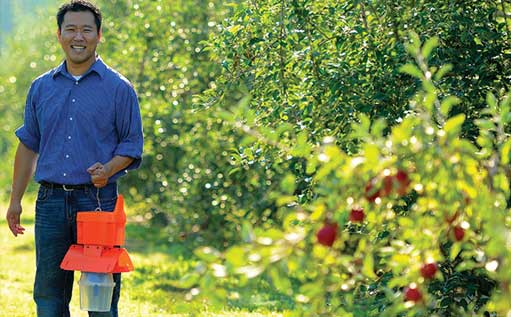
Before founding Spensa Technologies, the closest Johnny Park had come to farming was “driving down the highway next to a corn field. Now, his Z-Trap is using big data to help farmers control pests and increase crop yields.
Johnny Park was a professor and computer engineer at Purdue University in Lafayette, IN, on a campus surrounded by miles with cornfields. In 2008, he landed a grant to study how robotics and computer visioning could help farmers.
“I was fascinated by the opportunities that agriculture presented,” Johnny said. “It seemed like an area where I could really make a positive impact.”
Johnny learned about a problem that all farmers face: bugs and insects eating away at their crops. Most farmers would hang strips of sticky tape from trees to monitor pests, and decide where to apply pesticide. It was labor-intensive, expensive, and not very accurate.
With a small team, Johnny built the Z-Trap, a box with sensors that emits pheromones to attract pests. The Z-Trap tells farmers where pests are at any given time, but streaming data to the cloud.
Village Capital: Agriculture US 2014
In 2014, with his company Spensa Technologies consisting of two people, Johnny applied to Village Capital’s food and agriculture program in Louisville, Kentucky.
“Village Capital really helped the Spensa team refine our message to both investors and potential customers,” he said. “As a first time entrepreneur, I didn’t know about raising funds, or what a convertible note meant. We were taught what investors look for, and what pitfalls startups can fall into.”
His class of twelve AgTech entrepreneurs included companies working to increase resource efficiency, make crop production more efficient, and increase the productivity of small farms.
“Back then, there was no real community for AgTech entrepreneurs,” he said. “It seemed like a great way to learn from like-minded people - seeing others learning alongside me, experiencing bumps in the road together. It was encouraging and surprising.”
What’s next for Spensa
Since the program, Spensa has raised $1.3 million in convertible debt, in addition to a $630k grant from the National Science Foundation. In June 2015, Spensa raised a $2.5M Series A, including a follow-on investment from Village Capital.
Spensa’s team has grown from two people to more than 50, and in 2017 they expect to manage over five million acres of crops across four continents. The Z-Trap is expected to save enough crops to provide food for 20,000 people.
“Back when I started the company, it was pretty rare for a startup to succeed out of Lafayette, Indiana,” Johnny said. “We’ve come a long way.”
Our newsletters share the latest about our programs, trends, ecosystem leaders, and innovative entrepreneurs in the impact world. Get the latest insights, right in your inbox by subscribing:
Village Capital needs the contact information you provide to us to contact you about our products and services. You may unsubscribe from these communications at any time. For information on how to unsubscribe, as well as our privacy practices and commitment to protecting your privacy, please review our Privacy Policy.